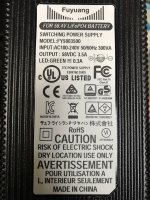noahsw said:
The standard charger is suitable but it doesn't look like it supports DC input. Figuring that out would be ideal though because as you say, it would keep me within warranty. Here's the label:
They won't say that they take DC, it's just that the design of most of this type of SMPS accepts it, as long as it is within the voltage range listed there.
Some of them will accept much lower voltages--I've used quite a few "wallwart" power adapters and such that have wide-range AC inputs 100-240vac, that also work down to 60vdc or less. Some will keep working even lower, but may not startup below that.
If you have a 60vdc battery you could try it on the two flat prongs of the wall plug of your charger. It's unlikely to damage anything, even if it won't start it up.
The LiPos are out of scope for me given their safety issues.
While RC Lipos are a special case, often dangerous due to little or no QC (to keep costs down) in both batteries and the chargers commonly used for them, keep in mind that no battery is "safe", especially in the case of a physical damage situation (like a crash/impact), and so you'd want to box any battery you carry around into a hard impact-resistant casing, with internal padding sufficient to keep the battery from moving around in there. Unfortunately it will make it quite a bit larger and at least a little heavier.

Regarding the mightmini pack, I've not personally had one of those, but I do have an older version that's similar:
https://endless-sphere.com/forums/viewtopic.php?f=14&t=81108
and I've had duct-tape-wrapped 18650 LiFePO4 packs, too.
If the MM is also a "loose" pack like mine have been, you'd need to put it into a hard case that can protect it in case of being dropped, or if you fell while carrying it on a ride, and landed on it, etc. If it's not protected, then like any other battery, it could be damaged in a way that either leaves it unsafe or nonfunctional, or less than fully functional (like if one of the parallel groups gets a cell interconnect broken so it is lower capacity/capability).
Note that the cases many batteries come in are not sufficient; like the Shark, Dolphin, etc etc; there have been some that were destroyed even in shipping, due to insufficient packing materials, because the cases simply aren't sturdy enough.
Pelican cases would work, but aren't cheap and aren't small. :/
I'm not sure how sturdy they are in impact situations, but the Grin Tech LiGo packs at http://ebikes.ca/ligo are designed to be handled and shipped, etc, individually, and might be an option if your converter has that voltage as an input option.


